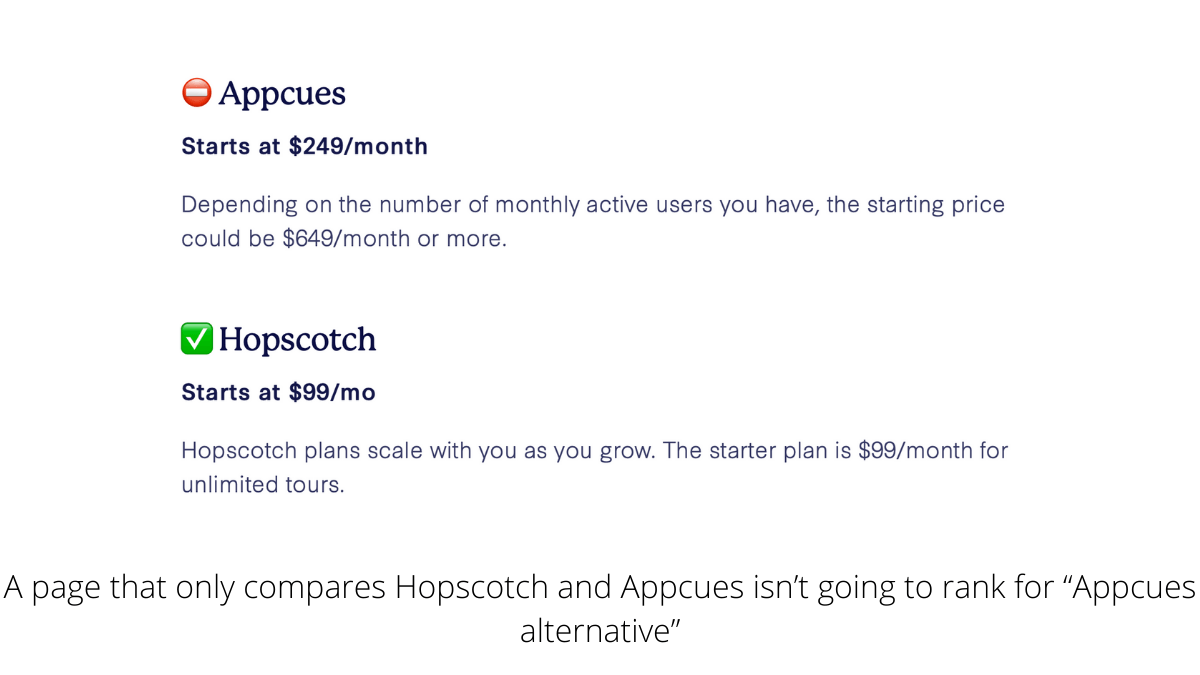Hopscotch is a user onboarding software that lets SaaS startups implement an interactive product tour.
Startups can show new users around the interface, and guide them to take action so they can hit the ground running using the product.

Firstly, I think they should change their name and branding.
There are already popular companies that share their name (and some even have a similar logo).
If people look up Hopscotch online, they’re always going to see others first.

This is a classic example of a good product with the wrong positioning.
Many of their competitors have a known brand, advanced features, and a higher price.
It’d make sense for Hopscotch to target new bootstrapped SaaS companies.

But their plans start from $99/month and I find it really hard to imagine a new founder using it.
I’d introduce a free plan as the default option for bootstrappers, betting that, as they grow, many will keep using it and move to a paid plan (starting from $25-50).

I’d also tweak the copy on their homepage.
If you’re a SaaS founder, “increase trial-to-paid conversions” sounds better than “guide your customers to success”.
Tell people you can help them make money and you’ll have their attention.

The illustration needs to go. It should be replaced by a screenshot of the actual product or - better yet - an animated gif showing the product at work.
Make sure all the CTAs have the same copy for the same target action. Otherwise, visitors might get confused.

Pro tip: most landing pages have social proof, but many do it wrong with the generic “This product is amazing” copy.
The goal of a testimonial section is to back up the claims made with your unique value proposition - use it to showcase specific experiences.

Free plans are great for getting initial users, as well as generating organic word of mouth.
In fact, the product tour for the free plan users should come with visible branding and a powered-by link to Hopscotch.

This won’t work until they have enough users. To kick-start it, I’d give away free plans to B2B SaaS companies.
Since B2Bs are used by other businesses, it’d give Hopscotch immediate, free, and targeted exposure.

They created comparison pages that get high-intent visitors, but they’re not ranking on the first page, and there’s a good reason for that.
If you analyze the SERP for “Appcues alternative,” you’ll see searchers want roundups where they can check out multiple options.

But Hopscotch isn’t doing that. They’re just comparing their product with Appcues.
They’re not matching the search intent and that’s why Google isn’t rewarding their page.
They need to change the content to a full roundup so they improve their ranking.

This often scares founders who don’t want to talk about their competitors.
The thing is, if others are doing it, they are influencing visitors with their point of view.
By not adapting to SERPs, you’re funneling customers their way.

Hopscotch also needs more links to rank well. Right now, they only have a few domains (many of which are nofollow).
They can use a backlink checker to analyze what their competitors are doing, and pick the domains they could pitch to get a backlink.

Another low-hanging fruit for links is founder appearances. If the founder appeared in interviews or podcasts, ask the hosts to update the links.
Similarly, do a web search; if someone mentioned your product, ask them to add a link. Works 99% of the time!

Social is missing from their radar. They only have an inactive Twitter account. Since SaaS founders love Twitter, that’s a missed opportunity.
Since they’re starting from zero, the best way to get exposure would be by taking part in relevant conversations.

